Starsky Robotics: Nine Component Business Model Evaluation
VerifiedAdded on 2023/06/08
|12
|2486
|346
Report
AI Summary
This report examines Starsky Robotics, an autonomous trucking firm, applying the nine-component business model canvas for analysis. The company, led by CEO Stefan Seltz-Axmacher, aims to revolutionize the logistics industry with self-driving trucks, reducing operational costs and increasing efficiency. The report details the company's customer segments, key partners, value proposition, key activities, channels, revenue streams, cost structure, key resources, and customer relationships. It highlights the interrelations among these blocks and identifies critical success factors such as technological innovation and strategic partnerships. The report also discusses potential downside risks, including market competition and technological challenges, and suggests business model changes to mitigate these risks. Recommendations include careful evaluation of autonomous vehicle deployment, risk diversification through partnerships, and the adoption of innovative strategies to achieve company goals. The report concludes that Starsky Robotics is making significant technological advancements and provides insights into its business strategies and potential for future growth.
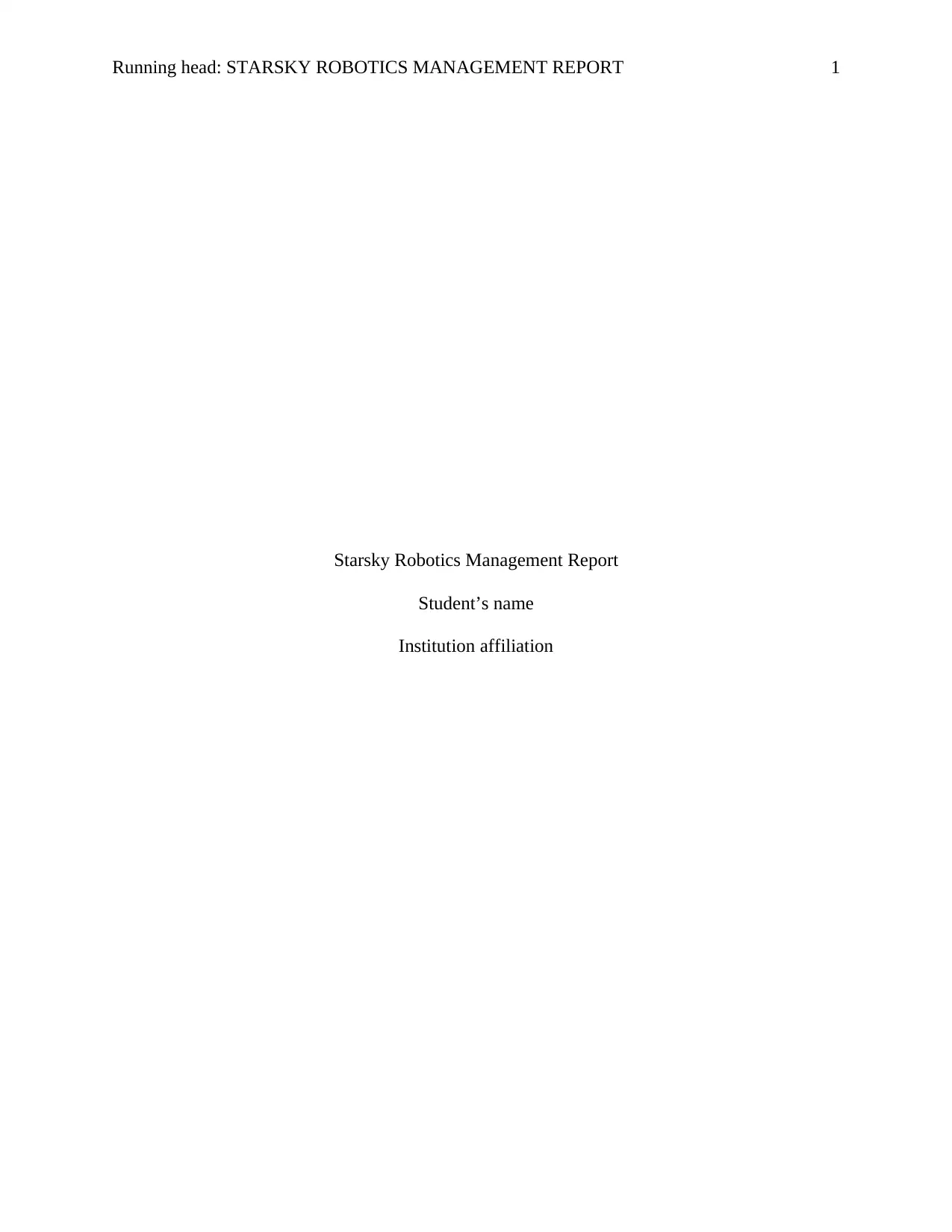
Running head: STARSKY ROBOTICS MANAGEMENT REPORT 1
Starsky Robotics Management Report
Student’s name
Institution affiliation
Starsky Robotics Management Report
Student’s name
Institution affiliation
Paraphrase This Document
Need a fresh take? Get an instant paraphrase of this document with our AI Paraphraser
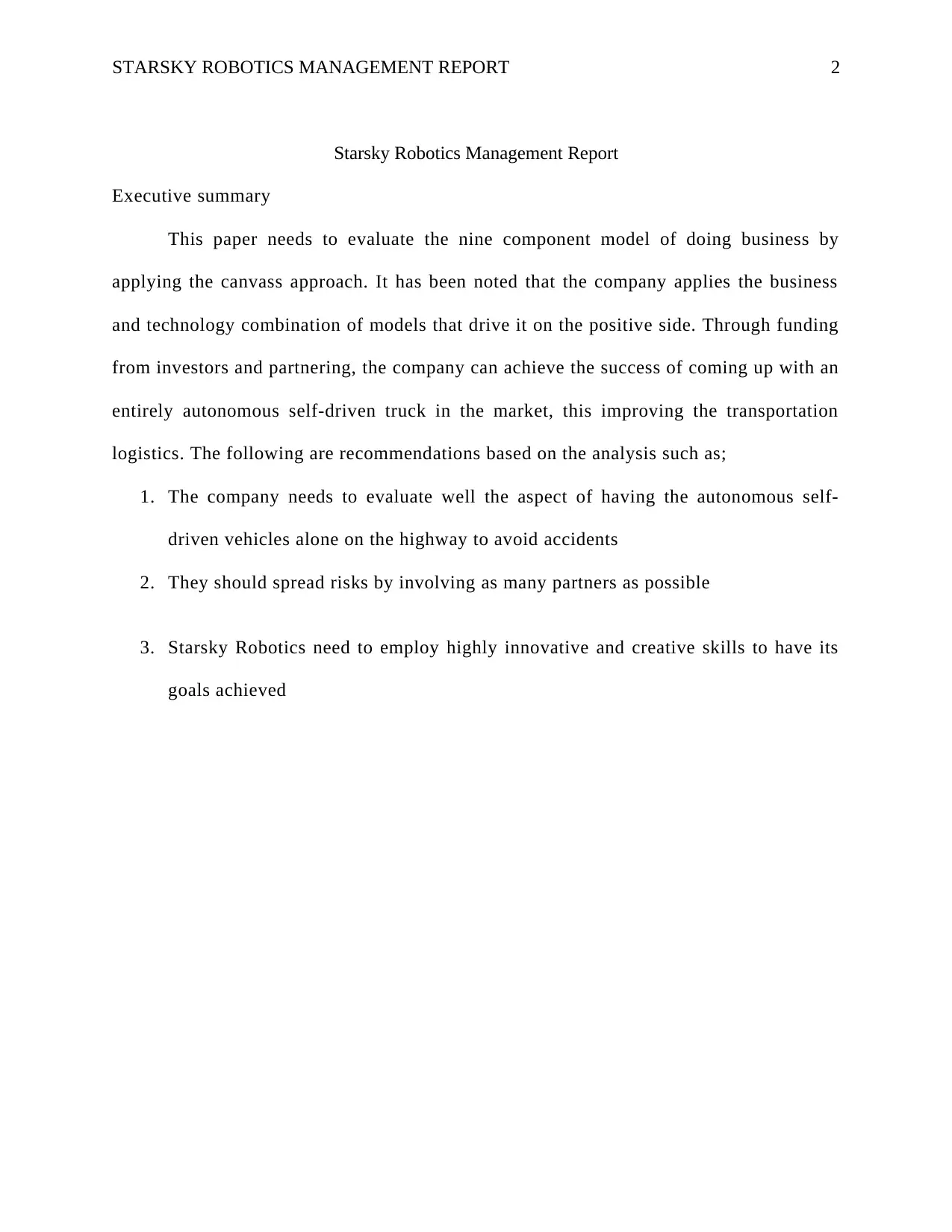
STARSKY ROBOTICS MANAGEMENT REPORT 2
Starsky Robotics Management Report
Executive summary
This paper needs to evaluate the nine component model of doing business by
applying the canvass approach. It has been noted that the company applies the business
and technology combination of models that drive it on the positive side. Through funding
from investors and partnering, the company can achieve the success of coming up with an
entirely autonomous self-driven truck in the market, this improving the transportation
logistics. The following are recommendations based on the analysis such as;
1. The company needs to evaluate well the aspect of having the autonomous self-
driven vehicles alone on the highway to avoid accidents
2. They should spread risks by involving as many partners as possible
3. Starsky Robotics need to employ highly innovative and creative skills to have its
goals achieved
Starsky Robotics Management Report
Executive summary
This paper needs to evaluate the nine component model of doing business by
applying the canvass approach. It has been noted that the company applies the business
and technology combination of models that drive it on the positive side. Through funding
from investors and partnering, the company can achieve the success of coming up with an
entirely autonomous self-driven truck in the market, this improving the transportation
logistics. The following are recommendations based on the analysis such as;
1. The company needs to evaluate well the aspect of having the autonomous self-
driven vehicles alone on the highway to avoid accidents
2. They should spread risks by involving as many partners as possible
3. Starsky Robotics need to employ highly innovative and creative skills to have its
goals achieved
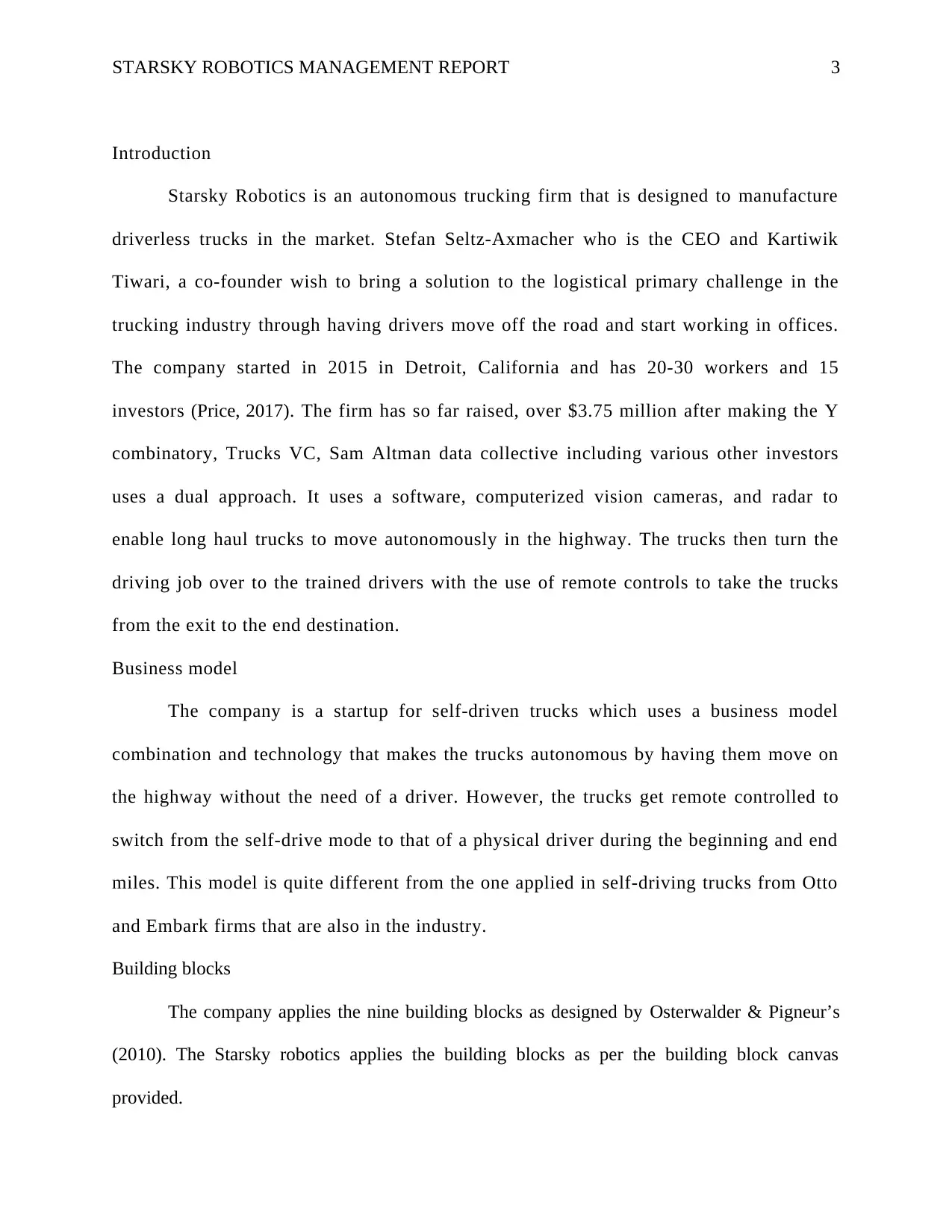
STARSKY ROBOTICS MANAGEMENT REPORT 3
Introduction
Starsky Robotics is an autonomous trucking firm that is designed to manufacture
driverless trucks in the market. Stefan Seltz-Axmacher who is the CEO and Kartiwik
Tiwari, a co-founder wish to bring a solution to the logistical primary challenge in the
trucking industry through having drivers move off the road and start working in offices.
The company started in 2015 in Detroit, California and has 20-30 workers and 15
investors (Price, 2017). The firm has so far raised, over $3.75 million after making the Y
combinatory, Trucks VC, Sam Altman data collective including various other investors
uses a dual approach. It uses a software, computerized vision cameras, and radar to
enable long haul trucks to move autonomously in the highway. The trucks then turn the
driving job over to the trained drivers with the use of remote controls to take the trucks
from the exit to the end destination.
Business model
The company is a startup for self-driven trucks which uses a business model
combination and technology that makes the trucks autonomous by having them move on
the highway without the need of a driver. However, the trucks get remote controlled to
switch from the self-drive mode to that of a physical driver during the beginning and end
miles. This model is quite different from the one applied in self-driving trucks from Otto
and Embark firms that are also in the industry.
Building blocks
The company applies the nine building blocks as designed by Osterwalder & Pigneur’s
(2010). The Starsky robotics applies the building blocks as per the building block canvas
provided.
Introduction
Starsky Robotics is an autonomous trucking firm that is designed to manufacture
driverless trucks in the market. Stefan Seltz-Axmacher who is the CEO and Kartiwik
Tiwari, a co-founder wish to bring a solution to the logistical primary challenge in the
trucking industry through having drivers move off the road and start working in offices.
The company started in 2015 in Detroit, California and has 20-30 workers and 15
investors (Price, 2017). The firm has so far raised, over $3.75 million after making the Y
combinatory, Trucks VC, Sam Altman data collective including various other investors
uses a dual approach. It uses a software, computerized vision cameras, and radar to
enable long haul trucks to move autonomously in the highway. The trucks then turn the
driving job over to the trained drivers with the use of remote controls to take the trucks
from the exit to the end destination.
Business model
The company is a startup for self-driven trucks which uses a business model
combination and technology that makes the trucks autonomous by having them move on
the highway without the need of a driver. However, the trucks get remote controlled to
switch from the self-drive mode to that of a physical driver during the beginning and end
miles. This model is quite different from the one applied in self-driving trucks from Otto
and Embark firms that are also in the industry.
Building blocks
The company applies the nine building blocks as designed by Osterwalder & Pigneur’s
(2010). The Starsky robotics applies the building blocks as per the building block canvas
provided.
⊘ This is a preview!⊘
Do you want full access?
Subscribe today to unlock all pages.

Trusted by 1+ million students worldwide
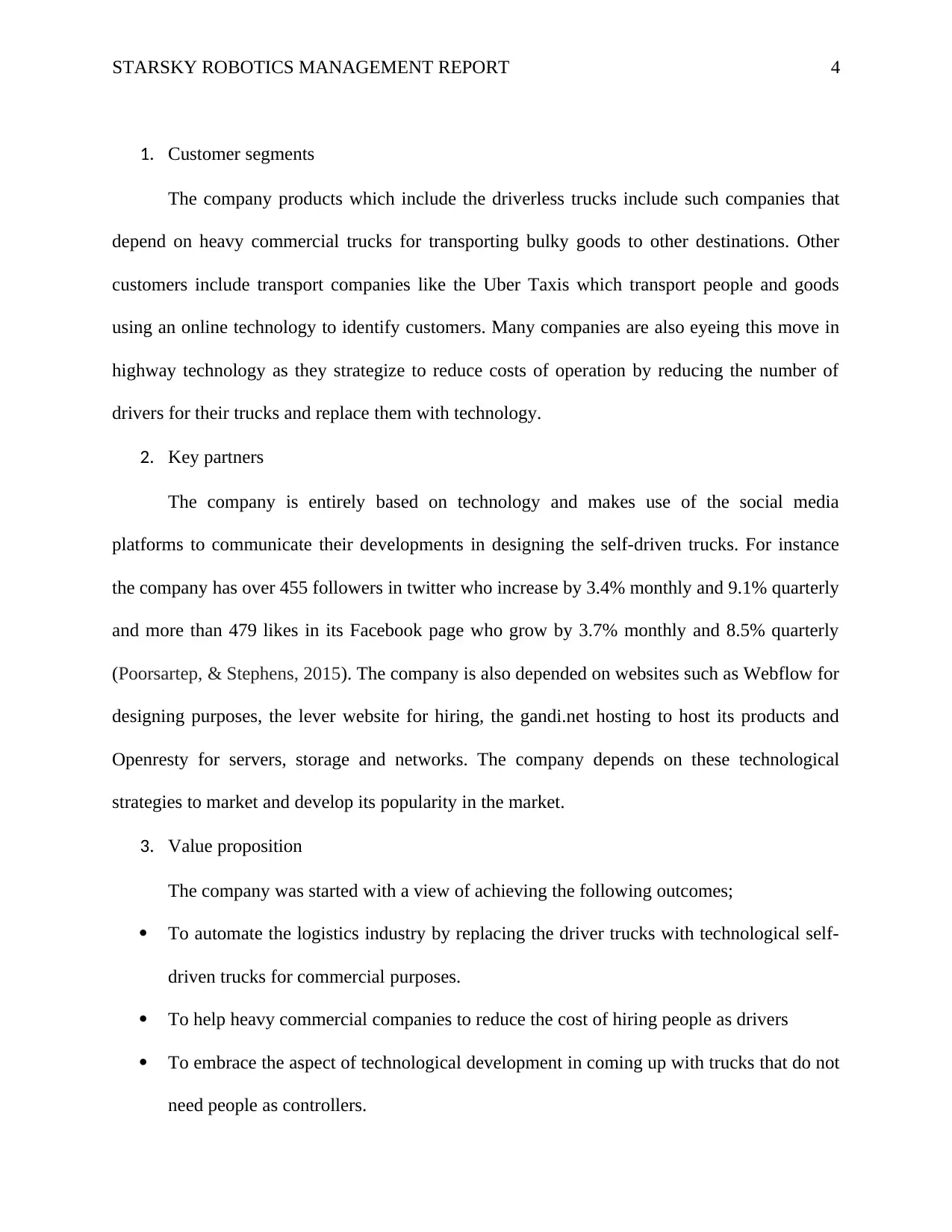
STARSKY ROBOTICS MANAGEMENT REPORT 4
1. Customer segments
The company products which include the driverless trucks include such companies that
depend on heavy commercial trucks for transporting bulky goods to other destinations. Other
customers include transport companies like the Uber Taxis which transport people and goods
using an online technology to identify customers. Many companies are also eyeing this move in
highway technology as they strategize to reduce costs of operation by reducing the number of
drivers for their trucks and replace them with technology.
2. Key partners
The company is entirely based on technology and makes use of the social media
platforms to communicate their developments in designing the self-driven trucks. For instance
the company has over 455 followers in twitter who increase by 3.4% monthly and 9.1% quarterly
and more than 479 likes in its Facebook page who grow by 3.7% monthly and 8.5% quarterly
(Poorsartep, & Stephens, 2015). The company is also depended on websites such as Webflow for
designing purposes, the lever website for hiring, the gandi.net hosting to host its products and
Openresty for servers, storage and networks. The company depends on these technological
strategies to market and develop its popularity in the market.
3. Value proposition
The company was started with a view of achieving the following outcomes;
To automate the logistics industry by replacing the driver trucks with technological self-
driven trucks for commercial purposes.
To help heavy commercial companies to reduce the cost of hiring people as drivers
To embrace the aspect of technological development in coming up with trucks that do not
need people as controllers.
1. Customer segments
The company products which include the driverless trucks include such companies that
depend on heavy commercial trucks for transporting bulky goods to other destinations. Other
customers include transport companies like the Uber Taxis which transport people and goods
using an online technology to identify customers. Many companies are also eyeing this move in
highway technology as they strategize to reduce costs of operation by reducing the number of
drivers for their trucks and replace them with technology.
2. Key partners
The company is entirely based on technology and makes use of the social media
platforms to communicate their developments in designing the self-driven trucks. For instance
the company has over 455 followers in twitter who increase by 3.4% monthly and 9.1% quarterly
and more than 479 likes in its Facebook page who grow by 3.7% monthly and 8.5% quarterly
(Poorsartep, & Stephens, 2015). The company is also depended on websites such as Webflow for
designing purposes, the lever website for hiring, the gandi.net hosting to host its products and
Openresty for servers, storage and networks. The company depends on these technological
strategies to market and develop its popularity in the market.
3. Value proposition
The company was started with a view of achieving the following outcomes;
To automate the logistics industry by replacing the driver trucks with technological self-
driven trucks for commercial purposes.
To help heavy commercial companies to reduce the cost of hiring people as drivers
To embrace the aspect of technological development in coming up with trucks that do not
need people as controllers.
Paraphrase This Document
Need a fresh take? Get an instant paraphrase of this document with our AI Paraphraser
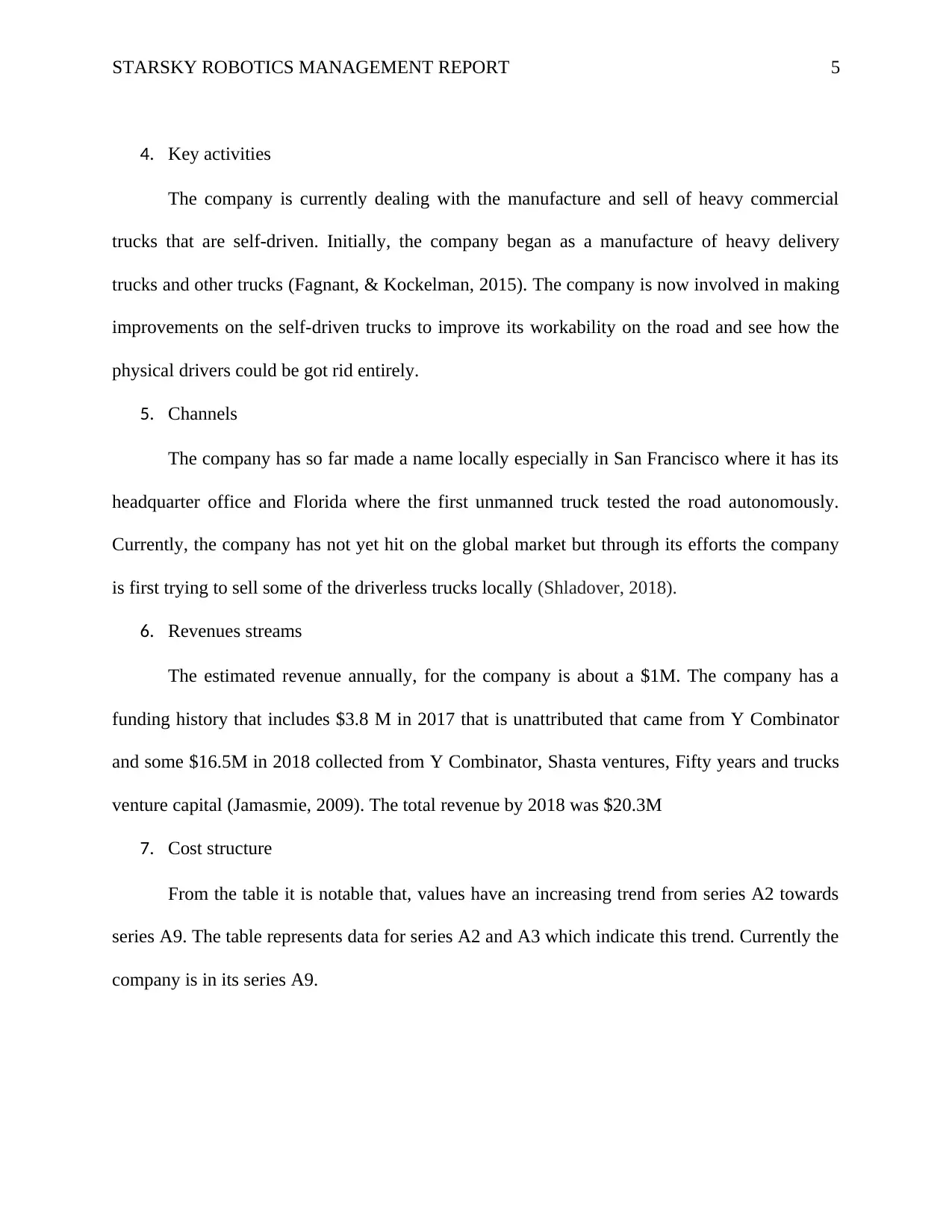
STARSKY ROBOTICS MANAGEMENT REPORT 5
4. Key activities
The company is currently dealing with the manufacture and sell of heavy commercial
trucks that are self-driven. Initially, the company began as a manufacture of heavy delivery
trucks and other trucks (Fagnant, & Kockelman, 2015). The company is now involved in making
improvements on the self-driven trucks to improve its workability on the road and see how the
physical drivers could be got rid entirely.
5. Channels
The company has so far made a name locally especially in San Francisco where it has its
headquarter office and Florida where the first unmanned truck tested the road autonomously.
Currently, the company has not yet hit on the global market but through its efforts the company
is first trying to sell some of the driverless trucks locally (Shladover, 2018).
6. Revenues streams
The estimated revenue annually, for the company is about a $1M. The company has a
funding history that includes $3.8 M in 2017 that is unattributed that came from Y Combinator
and some $16.5M in 2018 collected from Y Combinator, Shasta ventures, Fifty years and trucks
venture capital (Jamasmie, 2009). The total revenue by 2018 was $20.3M
7. Cost structure
From the table it is notable that, values have an increasing trend from series A2 towards
series A9. The table represents data for series A2 and A3 which indicate this trend. Currently the
company is in its series A9.
4. Key activities
The company is currently dealing with the manufacture and sell of heavy commercial
trucks that are self-driven. Initially, the company began as a manufacture of heavy delivery
trucks and other trucks (Fagnant, & Kockelman, 2015). The company is now involved in making
improvements on the self-driven trucks to improve its workability on the road and see how the
physical drivers could be got rid entirely.
5. Channels
The company has so far made a name locally especially in San Francisco where it has its
headquarter office and Florida where the first unmanned truck tested the road autonomously.
Currently, the company has not yet hit on the global market but through its efforts the company
is first trying to sell some of the driverless trucks locally (Shladover, 2018).
6. Revenues streams
The estimated revenue annually, for the company is about a $1M. The company has a
funding history that includes $3.8 M in 2017 that is unattributed that came from Y Combinator
and some $16.5M in 2018 collected from Y Combinator, Shasta ventures, Fifty years and trucks
venture capital (Jamasmie, 2009). The total revenue by 2018 was $20.3M
7. Cost structure
From the table it is notable that, values have an increasing trend from series A2 towards
series A9. The table represents data for series A2 and A3 which indicate this trend. Currently the
company is in its series A9.
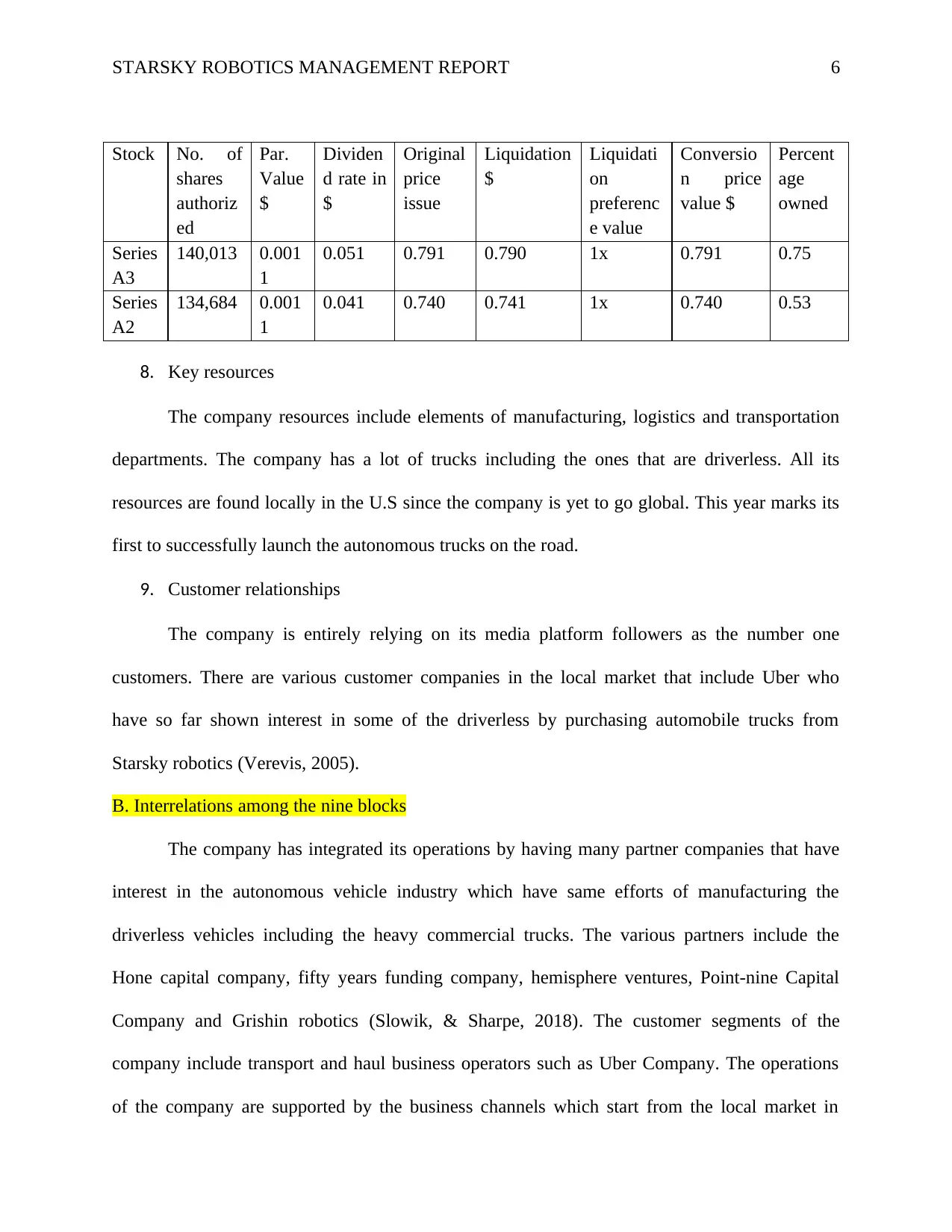
STARSKY ROBOTICS MANAGEMENT REPORT 6
Stock No. of
shares
authoriz
ed
Par.
Value
$
Dividen
d rate in
$
Original
price
issue
Liquidation
$
Liquidati
on
preferenc
e value
Conversio
n price
value $
Percent
age
owned
Series
A3
140,013 0.001
1
0.051 0.791 0.790 1x 0.791 0.75
Series
A2
134,684 0.001
1
0.041 0.740 0.741 1x 0.740 0.53
8. Key resources
The company resources include elements of manufacturing, logistics and transportation
departments. The company has a lot of trucks including the ones that are driverless. All its
resources are found locally in the U.S since the company is yet to go global. This year marks its
first to successfully launch the autonomous trucks on the road.
9. Customer relationships
The company is entirely relying on its media platform followers as the number one
customers. There are various customer companies in the local market that include Uber who
have so far shown interest in some of the driverless by purchasing automobile trucks from
Starsky robotics (Verevis, 2005).
B. Interrelations among the nine blocks
The company has integrated its operations by having many partner companies that have
interest in the autonomous vehicle industry which have same efforts of manufacturing the
driverless vehicles including the heavy commercial trucks. The various partners include the
Hone capital company, fifty years funding company, hemisphere ventures, Point-nine Capital
Company and Grishin robotics (Slowik, & Sharpe, 2018). The customer segments of the
company include transport and haul business operators such as Uber Company. The operations
of the company are supported by the business channels which start from the local market in
Stock No. of
shares
authoriz
ed
Par.
Value
$
Dividen
d rate in
$
Original
price
issue
Liquidation
$
Liquidati
on
preferenc
e value
Conversio
n price
value $
Percent
age
owned
Series
A3
140,013 0.001
1
0.051 0.791 0.790 1x 0.791 0.75
Series
A2
134,684 0.001
1
0.041 0.740 0.741 1x 0.740 0.53
8. Key resources
The company resources include elements of manufacturing, logistics and transportation
departments. The company has a lot of trucks including the ones that are driverless. All its
resources are found locally in the U.S since the company is yet to go global. This year marks its
first to successfully launch the autonomous trucks on the road.
9. Customer relationships
The company is entirely relying on its media platform followers as the number one
customers. There are various customer companies in the local market that include Uber who
have so far shown interest in some of the driverless by purchasing automobile trucks from
Starsky robotics (Verevis, 2005).
B. Interrelations among the nine blocks
The company has integrated its operations by having many partner companies that have
interest in the autonomous vehicle industry which have same efforts of manufacturing the
driverless vehicles including the heavy commercial trucks. The various partners include the
Hone capital company, fifty years funding company, hemisphere ventures, Point-nine Capital
Company and Grishin robotics (Slowik, & Sharpe, 2018). The customer segments of the
company include transport and haul business operators such as Uber Company. The operations
of the company are supported by the business channels which start from the local market in
⊘ This is a preview!⊘
Do you want full access?
Subscribe today to unlock all pages.

Trusted by 1+ million students worldwide
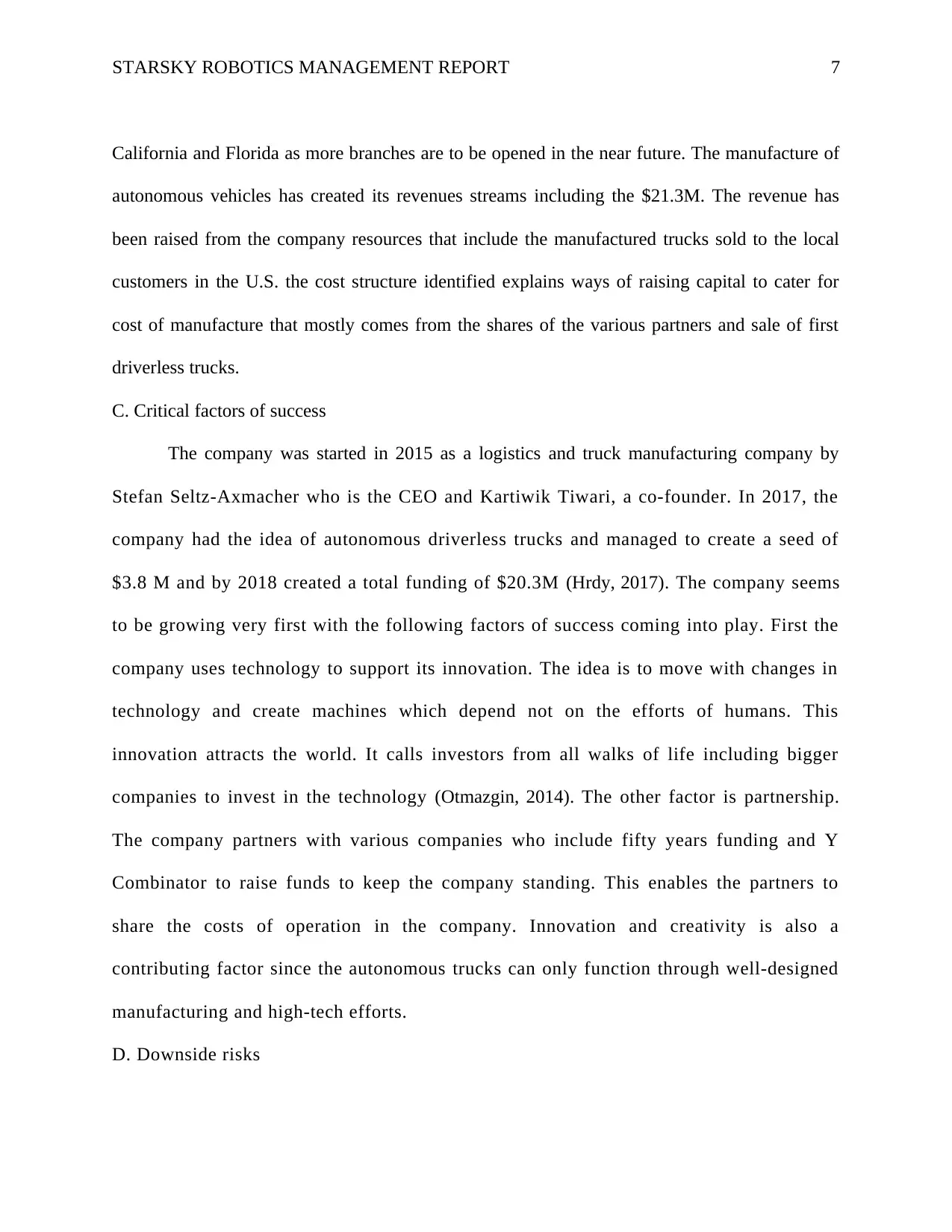
STARSKY ROBOTICS MANAGEMENT REPORT 7
California and Florida as more branches are to be opened in the near future. The manufacture of
autonomous vehicles has created its revenues streams including the $21.3M. The revenue has
been raised from the company resources that include the manufactured trucks sold to the local
customers in the U.S. the cost structure identified explains ways of raising capital to cater for
cost of manufacture that mostly comes from the shares of the various partners and sale of first
driverless trucks.
C. Critical factors of success
The company was started in 2015 as a logistics and truck manufacturing company by
Stefan Seltz-Axmacher who is the CEO and Kartiwik Tiwari, a co-founder. In 2017, the
company had the idea of autonomous driverless trucks and managed to create a seed of
$3.8 M and by 2018 created a total funding of $20.3M (Hrdy, 2017). The company seems
to be growing very first with the following factors of success coming into play. First the
company uses technology to support its innovation. The idea is to move with changes in
technology and create machines which depend not on the efforts of humans. This
innovation attracts the world. It calls investors from all walks of life including bigger
companies to invest in the technology (Otmazgin, 2014). The other factor is partnership.
The company partners with various companies who include fifty years funding and Y
Combinator to raise funds to keep the company standing. This enables the partners to
share the costs of operation in the company. Innovation and creativity is also a
contributing factor since the autonomous trucks can only function through well-designed
manufacturing and high-tech efforts.
D. Downside risks
California and Florida as more branches are to be opened in the near future. The manufacture of
autonomous vehicles has created its revenues streams including the $21.3M. The revenue has
been raised from the company resources that include the manufactured trucks sold to the local
customers in the U.S. the cost structure identified explains ways of raising capital to cater for
cost of manufacture that mostly comes from the shares of the various partners and sale of first
driverless trucks.
C. Critical factors of success
The company was started in 2015 as a logistics and truck manufacturing company by
Stefan Seltz-Axmacher who is the CEO and Kartiwik Tiwari, a co-founder. In 2017, the
company had the idea of autonomous driverless trucks and managed to create a seed of
$3.8 M and by 2018 created a total funding of $20.3M (Hrdy, 2017). The company seems
to be growing very first with the following factors of success coming into play. First the
company uses technology to support its innovation. The idea is to move with changes in
technology and create machines which depend not on the efforts of humans. This
innovation attracts the world. It calls investors from all walks of life including bigger
companies to invest in the technology (Otmazgin, 2014). The other factor is partnership.
The company partners with various companies who include fifty years funding and Y
Combinator to raise funds to keep the company standing. This enables the partners to
share the costs of operation in the company. Innovation and creativity is also a
contributing factor since the autonomous trucks can only function through well-designed
manufacturing and high-tech efforts.
D. Downside risks
Paraphrase This Document
Need a fresh take? Get an instant paraphrase of this document with our AI Paraphraser
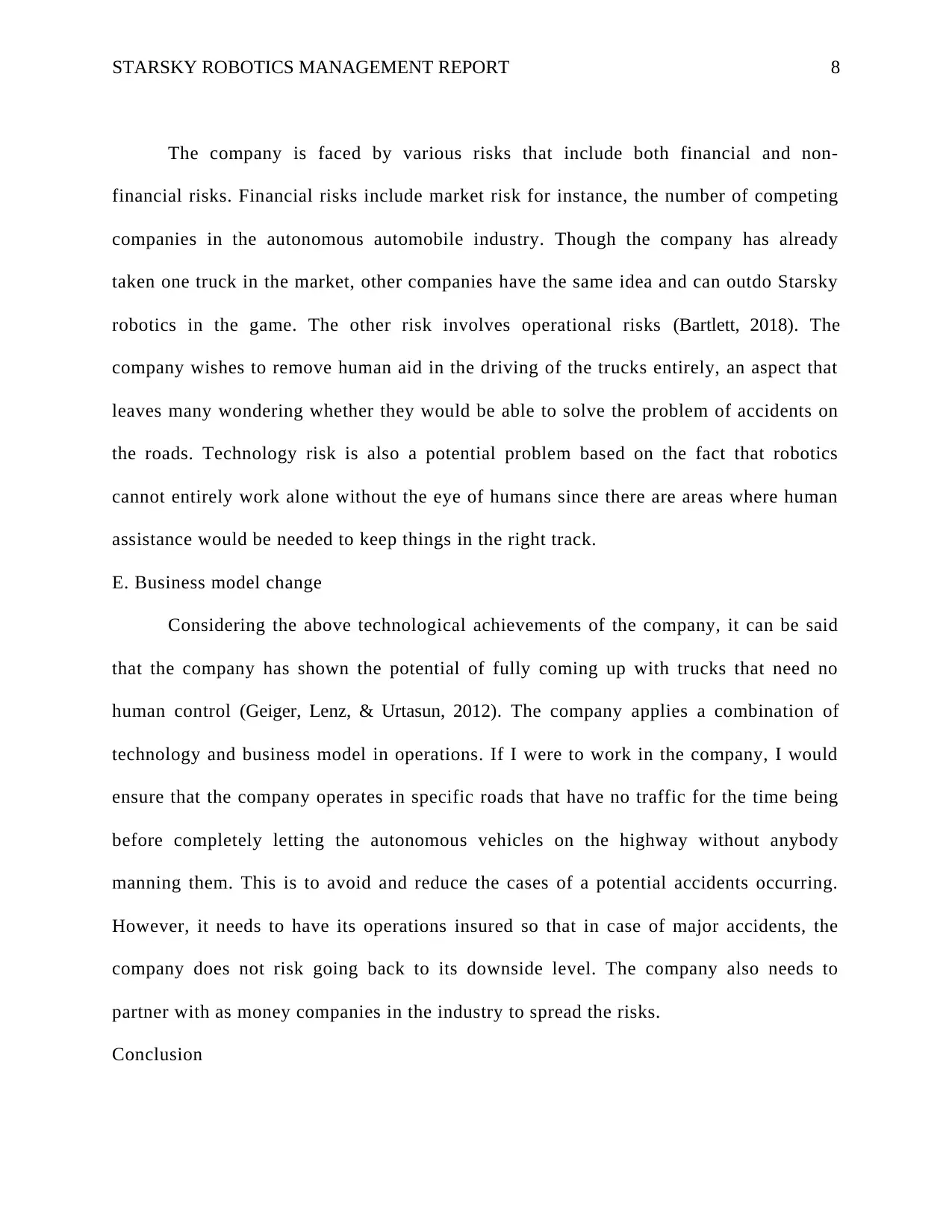
STARSKY ROBOTICS MANAGEMENT REPORT 8
The company is faced by various risks that include both financial and non-
financial risks. Financial risks include market risk for instance, the number of competing
companies in the autonomous automobile industry. Though the company has already
taken one truck in the market, other companies have the same idea and can outdo Starsky
robotics in the game. The other risk involves operational risks (Bartlett, 2018). The
company wishes to remove human aid in the driving of the trucks entirely, an aspect that
leaves many wondering whether they would be able to solve the problem of accidents on
the roads. Technology risk is also a potential problem based on the fact that robotics
cannot entirely work alone without the eye of humans since there are areas where human
assistance would be needed to keep things in the right track.
E. Business model change
Considering the above technological achievements of the company, it can be said
that the company has shown the potential of fully coming up with trucks that need no
human control (Geiger, Lenz, & Urtasun, 2012). The company applies a combination of
technology and business model in operations. If I were to work in the company, I would
ensure that the company operates in specific roads that have no traffic for the time being
before completely letting the autonomous vehicles on the highway without anybody
manning them. This is to avoid and reduce the cases of a potential accidents occurring.
However, it needs to have its operations insured so that in case of major accidents, the
company does not risk going back to its downside level. The company also needs to
partner with as money companies in the industry to spread the risks.
Conclusion
The company is faced by various risks that include both financial and non-
financial risks. Financial risks include market risk for instance, the number of competing
companies in the autonomous automobile industry. Though the company has already
taken one truck in the market, other companies have the same idea and can outdo Starsky
robotics in the game. The other risk involves operational risks (Bartlett, 2018). The
company wishes to remove human aid in the driving of the trucks entirely, an aspect that
leaves many wondering whether they would be able to solve the problem of accidents on
the roads. Technology risk is also a potential problem based on the fact that robotics
cannot entirely work alone without the eye of humans since there are areas where human
assistance would be needed to keep things in the right track.
E. Business model change
Considering the above technological achievements of the company, it can be said
that the company has shown the potential of fully coming up with trucks that need no
human control (Geiger, Lenz, & Urtasun, 2012). The company applies a combination of
technology and business model in operations. If I were to work in the company, I would
ensure that the company operates in specific roads that have no traffic for the time being
before completely letting the autonomous vehicles on the highway without anybody
manning them. This is to avoid and reduce the cases of a potential accidents occurring.
However, it needs to have its operations insured so that in case of major accidents, the
company does not risk going back to its downside level. The company also needs to
partner with as money companies in the industry to spread the risks.
Conclusion
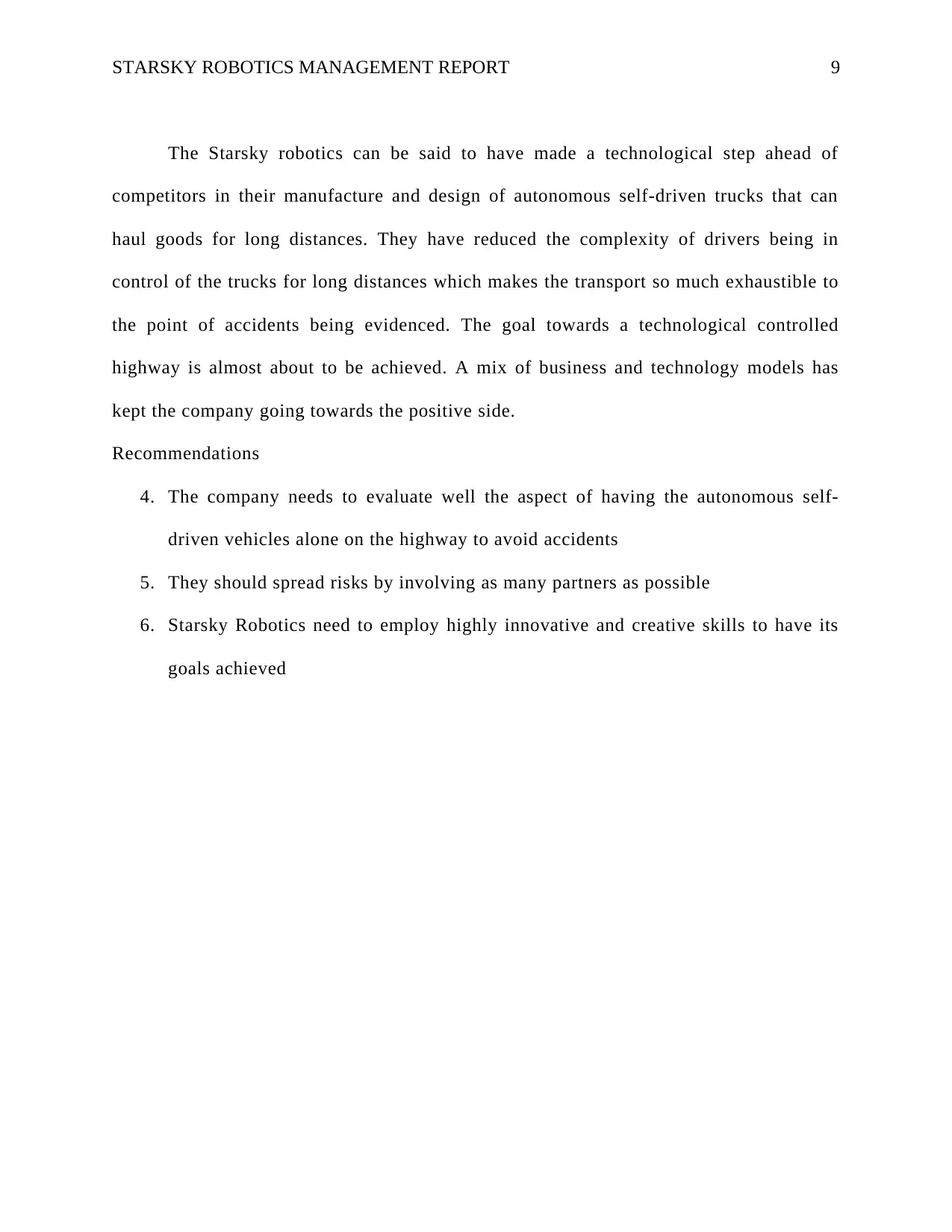
STARSKY ROBOTICS MANAGEMENT REPORT 9
The Starsky robotics can be said to have made a technological step ahead of
competitors in their manufacture and design of autonomous self-driven trucks that can
haul goods for long distances. They have reduced the complexity of drivers being in
control of the trucks for long distances which makes the transport so much exhaustible to
the point of accidents being evidenced. The goal towards a technological controlled
highway is almost about to be achieved. A mix of business and technology models has
kept the company going towards the positive side.
Recommendations
4. The company needs to evaluate well the aspect of having the autonomous self-
driven vehicles alone on the highway to avoid accidents
5. They should spread risks by involving as many partners as possible
6. Starsky Robotics need to employ highly innovative and creative skills to have its
goals achieved
The Starsky robotics can be said to have made a technological step ahead of
competitors in their manufacture and design of autonomous self-driven trucks that can
haul goods for long distances. They have reduced the complexity of drivers being in
control of the trucks for long distances which makes the transport so much exhaustible to
the point of accidents being evidenced. The goal towards a technological controlled
highway is almost about to be achieved. A mix of business and technology models has
kept the company going towards the positive side.
Recommendations
4. The company needs to evaluate well the aspect of having the autonomous self-
driven vehicles alone on the highway to avoid accidents
5. They should spread risks by involving as many partners as possible
6. Starsky Robotics need to employ highly innovative and creative skills to have its
goals achieved
⊘ This is a preview!⊘
Do you want full access?
Subscribe today to unlock all pages.

Trusted by 1+ million students worldwide
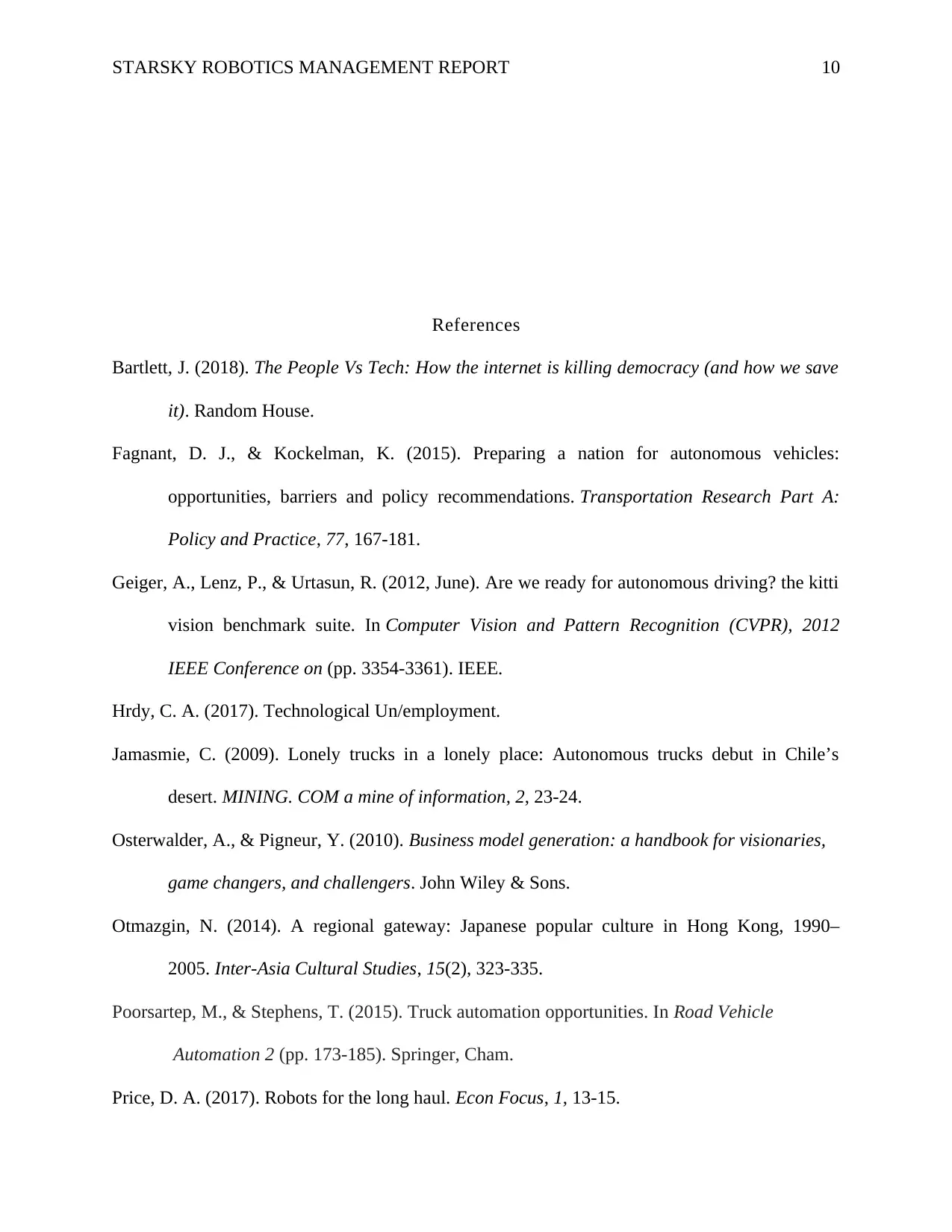
STARSKY ROBOTICS MANAGEMENT REPORT 10
References
Bartlett, J. (2018). The People Vs Tech: How the internet is killing democracy (and how we save
it). Random House.
Fagnant, D. J., & Kockelman, K. (2015). Preparing a nation for autonomous vehicles:
opportunities, barriers and policy recommendations. Transportation Research Part A:
Policy and Practice, 77, 167-181.
Geiger, A., Lenz, P., & Urtasun, R. (2012, June). Are we ready for autonomous driving? the kitti
vision benchmark suite. In Computer Vision and Pattern Recognition (CVPR), 2012
IEEE Conference on (pp. 3354-3361). IEEE.
Hrdy, C. A. (2017). Technological Un/employment.
Jamasmie, C. (2009). Lonely trucks in a lonely place: Autonomous trucks debut in Chile’s
desert. MINING. COM a mine of information, 2, 23-24.
Osterwalder, A., & Pigneur, Y. (2010). Business model generation: a handbook for visionaries,
game changers, and challengers. John Wiley & Sons.
Otmazgin, N. (2014). A regional gateway: Japanese popular culture in Hong Kong, 1990–
2005. Inter-Asia Cultural Studies, 15(2), 323-335.
Poorsartep, M., & Stephens, T. (2015). Truck automation opportunities. In Road Vehicle
Automation 2 (pp. 173-185). Springer, Cham.
Price, D. A. (2017). Robots for the long haul. Econ Focus, 1, 13-15.
References
Bartlett, J. (2018). The People Vs Tech: How the internet is killing democracy (and how we save
it). Random House.
Fagnant, D. J., & Kockelman, K. (2015). Preparing a nation for autonomous vehicles:
opportunities, barriers and policy recommendations. Transportation Research Part A:
Policy and Practice, 77, 167-181.
Geiger, A., Lenz, P., & Urtasun, R. (2012, June). Are we ready for autonomous driving? the kitti
vision benchmark suite. In Computer Vision and Pattern Recognition (CVPR), 2012
IEEE Conference on (pp. 3354-3361). IEEE.
Hrdy, C. A. (2017). Technological Un/employment.
Jamasmie, C. (2009). Lonely trucks in a lonely place: Autonomous trucks debut in Chile’s
desert. MINING. COM a mine of information, 2, 23-24.
Osterwalder, A., & Pigneur, Y. (2010). Business model generation: a handbook for visionaries,
game changers, and challengers. John Wiley & Sons.
Otmazgin, N. (2014). A regional gateway: Japanese popular culture in Hong Kong, 1990–
2005. Inter-Asia Cultural Studies, 15(2), 323-335.
Poorsartep, M., & Stephens, T. (2015). Truck automation opportunities. In Road Vehicle
Automation 2 (pp. 173-185). Springer, Cham.
Price, D. A. (2017). Robots for the long haul. Econ Focus, 1, 13-15.
Paraphrase This Document
Need a fresh take? Get an instant paraphrase of this document with our AI Paraphraser
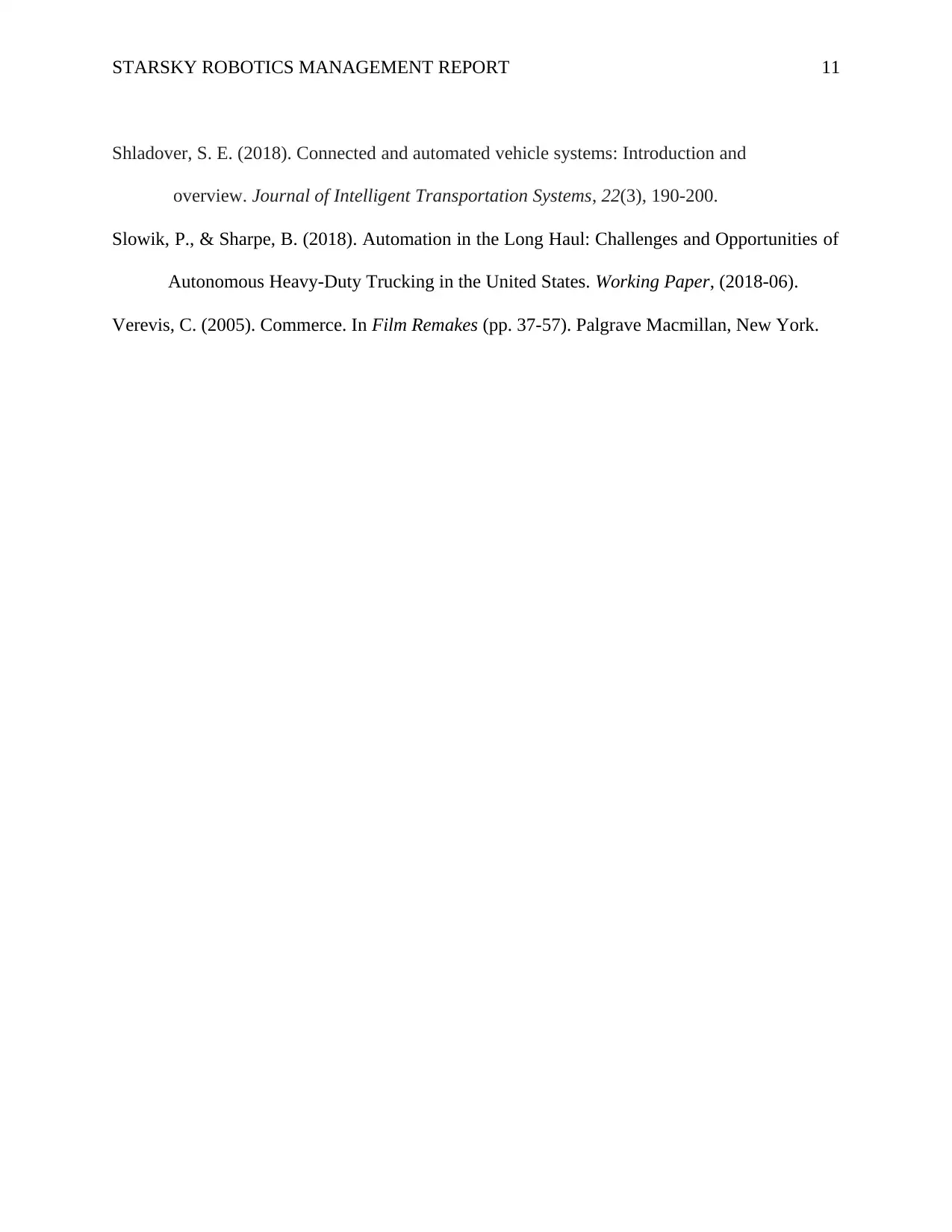
STARSKY ROBOTICS MANAGEMENT REPORT 11
Shladover, S. E. (2018). Connected and automated vehicle systems: Introduction and
overview. Journal of Intelligent Transportation Systems, 22(3), 190-200.
Slowik, P., & Sharpe, B. (2018). Automation in the Long Haul: Challenges and Opportunities of
Autonomous Heavy-Duty Trucking in the United States. Working Paper, (2018-06).
Verevis, C. (2005). Commerce. In Film Remakes (pp. 37-57). Palgrave Macmillan, New York.
Shladover, S. E. (2018). Connected and automated vehicle systems: Introduction and
overview. Journal of Intelligent Transportation Systems, 22(3), 190-200.
Slowik, P., & Sharpe, B. (2018). Automation in the Long Haul: Challenges and Opportunities of
Autonomous Heavy-Duty Trucking in the United States. Working Paper, (2018-06).
Verevis, C. (2005). Commerce. In Film Remakes (pp. 37-57). Palgrave Macmillan, New York.
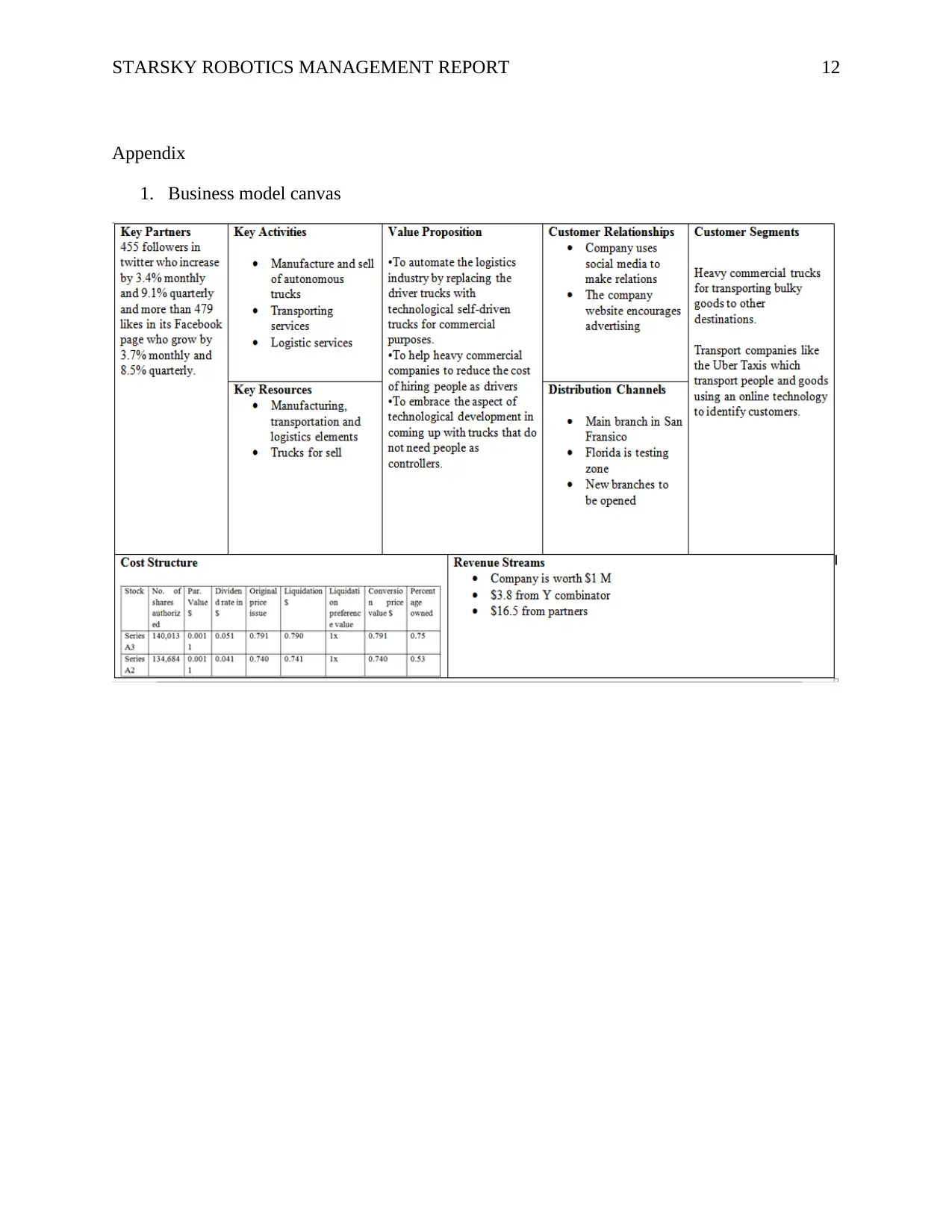
STARSKY ROBOTICS MANAGEMENT REPORT 12
Appendix
1. Business model canvas
Appendix
1. Business model canvas
⊘ This is a preview!⊘
Do you want full access?
Subscribe today to unlock all pages.

Trusted by 1+ million students worldwide
1 out of 12
Related Documents
Your All-in-One AI-Powered Toolkit for Academic Success.
+13062052269
info@desklib.com
Available 24*7 on WhatsApp / Email
![[object Object]](/_next/static/media/star-bottom.7253800d.svg)
Unlock your academic potential
Copyright © 2020–2025 A2Z Services. All Rights Reserved. Developed and managed by ZUCOL.




